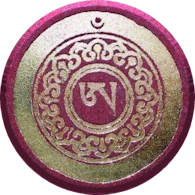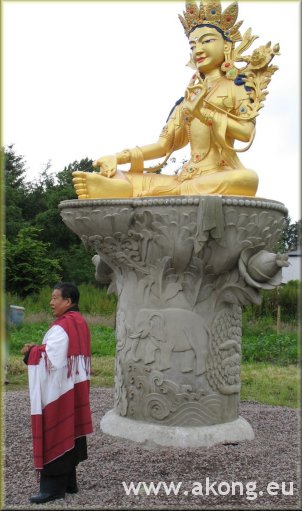
Akong Rinpoché Establishing Buddha-Dharma
Part One: Overview, Establishing the Supports
of the Three Jewels and the Three Roots
 The activity of an enlightened being is often described in hagiographies through their work in “benefiting the dharma and benefiting sentient beings”. The former of these is, in turn, described through both what they achieved and their personal qualities in so doing.
The activity of an enlightened being is often described in hagiographies through their work in “benefiting the dharma and benefiting sentient beings”. The former of these is, in turn, described through both what they achieved and their personal qualities in so doing.
The dharma deeds are summed up through establishing the supports of the Three Jewels and the Three Roots. Those of the Three Jewels are:
![]() 1. The statues, thangkas, stupas and other representations of the Buddha, properly consecrated and containing relics, as well as the temples to contain them.
1. The statues, thangkas, stupas and other representations of the Buddha, properly consecrated and containing relics, as well as the temples to contain them.
![]() 2. The texts, libraries and material facilities that preserve the dharma as teachings and the creation of human possibilities that enable the transmission and practice of the dharma as realisation, through creating training facilities such as retreats and hermitages.
2. The texts, libraries and material facilities that preserve the dharma as teachings and the creation of human possibilities that enable the transmission and practice of the dharma as realisation, through creating training facilities such as retreats and hermitages.
![]() 3. The viharas that serve as correct lodgings and pure places of ordination, according to the vinaya, for the ordained sangha.
3. The viharas that serve as correct lodgings and pure places of ordination, according to the vinaya, for the ordained sangha.
The body, speech and mind supports for the Three Roots (gurus, yidams and protectors) are very similar to the above but in respect of the Vajrayana transmissions:
![]() 1. Suitable abodes for currently-living bodhisattvas and gurus, where they can be properly respected and met with, as living gurus as opposed to the symbolic images and relics of the past Buddha and saints. There are also the statues, thangkas, mandalas and other images related to Vajrayana practice, as well as all the ritual artefacts, such as musical instruments, tormas, offering mandalas and so forth.
1. Suitable abodes for currently-living bodhisattvas and gurus, where they can be properly respected and met with, as living gurus as opposed to the symbolic images and relics of the past Buddha and saints. There are also the statues, thangkas, mandalas and other images related to Vajrayana practice, as well as all the ritual artefacts, such as musical instruments, tormas, offering mandalas and so forth.
![]() 2. The scriptures of the Vajrayana tantras and the retreats, hermitages and yoga rooms needed for the transmission of the various levels of tantric practice and yoga.
2. The scriptures of the Vajrayana tantras and the retreats, hermitages and yoga rooms needed for the transmission of the various levels of tantric practice and yoga.
![]() 3. Tantric viharas and retreats suited to the disciplinary guidelines of tantric samaya.
3. Tantric viharas and retreats suited to the disciplinary guidelines of tantric samaya.
Akong Rinpoché showed great vision and diligence in establishing all the above, doing so with great success. Over the years, he often outlined his life-missions, in varying lists, but latterly saying that the completion of the Samyé College was the only outstanding one on his original list of five dharma missions for this life:
1. Construction of Samye Temple
2. Establish teachings of main Mahayana and Vajrayana texts used in the Kagyu tradition.
3. Establish Mahamudra in all its aspects, especially as practice. This aspect of the Kagyu teachings is known as drol lam, the Path of Liberation.
4. Establish long-term retreats for the practice of the main Kagyu guru-yogas, yidam practices and particularly the Six Yogas of Naropa. This aspect is known as thab lam, the Path of Skilful Means.
5. Construction of Samye College & Library building.
Sadly, yet perhaps inevitably, his death occurred only weeks after the completion of the last main feature of the College and Library building, the building of its entrance portal.
At times Akong Rinpoché would add two more to this list of life tasks:
6. Establish Tara therapy system
7. Establish Rokpa humanitarian
Under these last two came many other projects, such as the Tibetan Medicine course and clinics, under Tara, and the enormous activity in Tibet and Nepal of Rokpa. To these should be added innumerable projects in many countries that only saw the light of day due to the inspiration or encouragement of Rinpoché to their main founders. Furthermore, one must consider the international development of Samye Lings and Samye Dzongs (see dedicated pages). Rinpoché never drew a line between “dharma” (in the religious sense) and his other work, such as Tara and Rokpa. For him it was all dharma.
He in fact explained dharma through its Tibetan etymology, meaning “to heal” or “to restore”. He saw his duty as being to heal the world, on all levels. It was a fascinating part of Akong Rinpoché’s own being and activity that he would labour to perpetuate all the myriad symbolic aspects of Tibetan Buddhism—the “skilful means”—yet never fell into the trap of confusing the means with the end.
For the first, he became known as one of the most traditional Tibetan lamas in the West, wary of the innovative methods favoured by some and deeply concerned for the preservation of the Tibetan traditions by making them living, practised traditions in the West. He was strict about Refuge, precepts, the Vinaya, the bodhisattva vow and tantric vows being taken and kept properly and traditionally. He put endless effort into creating religious artefacts—tormas, musical instruments, costumes and so forth—to a high quality and ensuring that they were then used correctly. This sometimes involved bringing experts over from Sherab Ling or elsewhere but he deemed it all worthwhile.
However, while so doing he was crystal clear that all those things are symbols, the famous “finger pointing at the moon that should not be mistaken for the moon”, and knew that they symbolise wisdom and compassion in their many manifestations. He was one of the rare Tibetan lamas to recognise and/or foster the development of wisdom and compassion in many different ways, whether it be through Tara or Rokpa or other channels not seemingly religious and to know them all to be equally “dharma”. He himself was interested to see whether, as years went by, it was his Western lamas or his Tara therapy teachers ended up with best insight into the mind and whether it was his Rokpa people or his lamas and sangha who developed equal hearts of compassion.
......continue to the next part of the story: an Initial Hesitation
